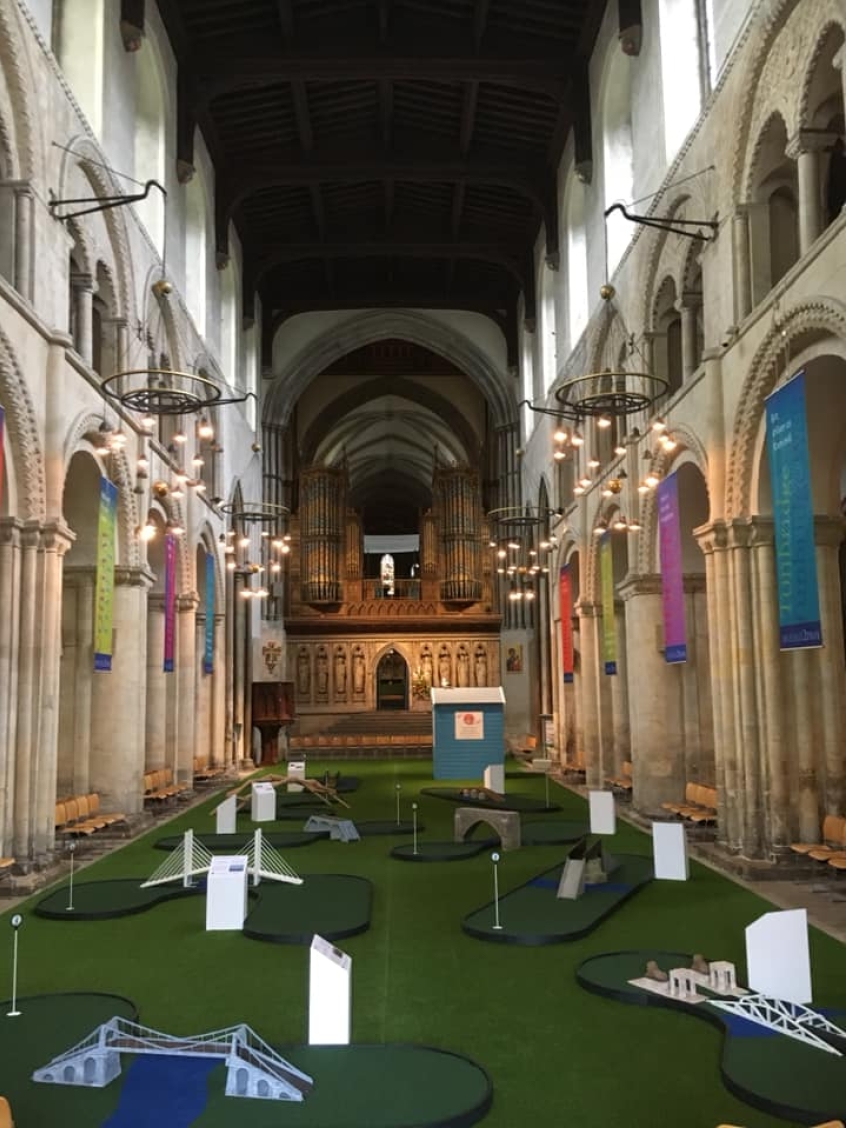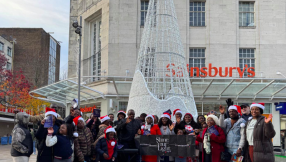
Another unusual use of a cathedral—another slew of 'Disgusted, Tunbridge Wells' letters to the press. That, at least, is how it often feels. The latest episode of this is the conversion of the nave of Rochester Cathedral to be used as a crazy golf course, with each hole featuring a bridge to be crossed, for the duration of the summer.
This follows other similar adaptations, including artist Luke Jerram's Moon installation doing the rounds of a series of cathedrals and larger church buildings, and controversy surrounding Derby Cathedral showing films about paganism featuring full-frontal nudity.
Norwich Cathedral planned to install a helter skelter (though I don't know whether that ever actually happened), and Gloucester Cathedral turned itself into an indoor skate park in 2016, and appeared to avoid the negative comments. And in a similar venture, Blackburn Cathedral produced and sold its own brand of gin to raise funds. It does seem that the entrepreneurial spirit is alive and well in our cathedrals!
Such controversies inevitably give rise to awful headline puns, and this one is no exception. 'Let us putt' is the weak offering from the Times; the Daily Mail beats that with 'Holy in One'; whilst the Sun offers a 'Fairway to Heaven'. My personal favourite is the suggestion that the cathedral is now moving in the 'par of the Holy Spirit'. But the objections were expressed more directly.
The idea has been met with horror from parishioners and clergy – including some who were ordained there – who say the Church of England is dumbing down and the course is an 'embarrassing shambles' and 'sad and painful.'
'Rochester Cathedral was founded in AD 604. It survived the Norman Conquest, 2 fires in the 12th century, and several rounds of pillaging. St. William of Perth is buried there. And now*'
'What an embarrassing shambles.'
'Wonder what the shades of the holy Benedictines who built these places think.'
'Rochester cathedral's idea of mission. So devoid of theology they have forgotten 'This is none other than the house of God; this is the gate of heaven'. Shame on you.'
Is there any merit in these criticisms, or are they just the usual moaners and nay-sayers? (In our new political climate, we cannot tolerate negative attitudes...!)
The theologically most substantial criticism comes from those who see the cathedral as a holy building which somehow distinctively encloses the presence of God. There is some irony that the quotation 'This is none other than the house of God; this is the gate of heaven' is taken from the story of Jacob's vision of a ladder to heaven in Genesis 28:10-19—which took place away from any sacred building! But it has long been associated with a theology of church buildings, so much so that, for example, the front of Bath Abbey is decorated with two carved ladders on which angels ascend and descend on the outside of the West end.
Dr Michael Lakey, formerly tutor at Ripon College, Cuddesdon, outside Oxford, expresses this understanding of sacred space:
A sanctuary, and the liturgy enacted in it, is an idealised representation of universal and archetypical relationships between God and the cosmos as it ought to be (think of the way that the biblical temple represented the Hebrew cosmos with its metal sea and its creation-themed decor). In the Sibylline Oracles, there is a text about the eschatological temple which describes it as vast enough to serve the entire creation (there are similar ideas at play in 1 Enoch and in the final chapter of Revelation). In that sense, I think the Church as Temple is always ideally more or less representative of God and the World in idealised relationship.

This understanding was clearly an important part of Jewish understandings of the temple building, which is why the destruction of the first temple at the end of 2 Kings, and the destruction of the second temple by the Romans in 70 AD were both such traumatic events for both the Jews sense of identity and their theological understanding of God and worship.
The problem with applying this temple language to contemporary (including historical) church buildings is that the New Testament consistently transfers the language of sacred space to Jesus and his followers—as Michael Lakey goes on to point out. In John 2, Jesus refers to his own body as a temple. In keeping with his theology of disciples as the body of Christ, Paul extends the temple language to the Christians in Corinth both as individuals and collectively in 1 Cor 3–5. And the climactic section of Romans 12, in which we are exhorted to 'offer your bodies as living sacrifices' is cultic and sanctuary language. For this reason, Protestant churches have been very reluctant to re-appropriate this kind of temple language for buildings.
(It could be argued that Paul was leading a long and mobile movement, and so doesn't answer the question of what Christianity, once settled, might think about its buildings. In fact Judaism, both in Judea and in the Diaspora, offered an answered, as synagogues became increasingly like replicas of the temple in the first century, with the far end holding the Torah scrolls functioning as a sanctuary. So the local-meeting-place-as-temple option was available to Paul.)
This might then mean, at least in principle, that we can be fairly flexible in our use of our buildings. This is the reason why churches local to me have used their buildings to host film nights (though with the titles carefully chosen) or to screen showings of, for example, significant football matches. (We even watched World Cup matches at Synod last year!) It is reasonably well documented that the distinctive feel of historic church buildings can be off-putting for people not used to church culture, so many of the new Anglican Church plants are using non-traditional buildings, as are many of the 'new churches'; Trent Vineyard, local to me, meets on an industrial estate in a re-purposed factory warehouse, and in a neat reversal of use, a church is being planted using central Strategic Development Funding in a former nightclub in Bradford.
This kind of connection and bridge building (pun intended!) is clearly in some of the thinking behind the Rochester project.
The Revd. Rachel Phillips, Canon for Mission and Growth at Rochester Cathedral, said: 'For over 1,400 years, Rochester Cathedral has been a centre of learning for the community. By temporarily installing an educational adventure golf course we aim to continue that mission, giving people the opportunity to learn while they take part in a fun activity, in what for many might be a previously unvisited building.'
The Revd. Canon Matthew Rushton, Canon Precentor, at Rochester Cathedral said: 'The nave of a cathedral has always been a public space, where the sacred and the secular meet. The adventure golf at Rochester Cathedral is primarily a joint education project with the Rochester Bridge Trust to get young people, with their families, engaged with engineering and bridge building – and it's fun!
'Worship in the Cathedral is unaffected. We continue to have at least 3 services a day and people can come in to light a candle, to pray or be quiet in areas of the Cathedral other than the Nave.'
But this approach raises another series of questions. Matthew Rushton's comments assume an answer to the question 'To whom does this space belong?' or perhaps 'Who is it for?' A well-worn Protestant answer is that church buildings are not the house of God, but the house of the people of God, a place set aside for the purpose of the people of God meeting for worship, for the building of relationships, and a sacred space where the good news of Jesus may be encountered by those who visit. I asked someone involved in hosting the Moon art installation whether there would be any accompanying reflection helping those who visit to connect what they were seeing with Christian faith. The answer came back: 'No: the terms of the installation were that it had to be free-standing from any other comment.' I think I found that problematic. Rochester are not succumbing to that; Rachel Phillips comments:
We hope that when people come in, they will know that they're welcome and they will have an enjoyable experience. So while people are here, having fun and playing crazy golf, they will take the opportunity to reflect on that wider theme of building bridges that they might find that they would like to pray, light a candle. Maybe talk to somebody. We hope that we'll reach more people with the message the good news that Christians have to bring that Jesus came to bring peace.
So it will be interesting to see whether there is any evidence from the cathedrals that these public events do in fact lead to an increase in attendance at services of worship, and people coming to faith in Jesus.
The question of to whom these spaces belong is largely answered by the question of consecration. Unlike other denominations, because the Church of England is established by law, consecration of Anglican buildings effects a change in their legal status, and that in turn puts limits on what uses they can be put to.
When property has been consecrated it is set apart solely for sacred purposes for all time (but see below). This is effected by the Bishop signing the sentence of consecration. In the case of ancient parish churches, consecration is presumed. It is only when consecrated that a building becomes in the eyes of the law a church.
Certain uses are therefore ruled out, including (as recently demonstrated) the possibility of Anglican buildings being used, even temporarily, for the worship of another faith. In the past, the question of consecration has been key in legal disputes; in 1863, a vicar pulled out the pew which was the habitual seat of the owner of the local Manor House, and he responded by arguing that the vicar had no right to do so, since the building had mostly been demolished and rebuilt and therefore no longer counted as consecrated! Nowadays, this idea of consecrated points us more helpfully to the theological and pastoral sense, that these buildings are, in some sense, set apart not for one group of people or another, but for God.
But, it might be answered, if church buildings are for God, and God is lord of all, surely all of life should find its place there? There is some evidence that medieval church buildings did function as community centres, and the lack of pews in many of them (either because of the use of chairs, or more likely because people stood all through the service of worship) enabled that to happen easily; for many older buildings, the addition of pews was a Victorian innovation.
That then leads us to a sense of perception of whether the use of a church building space is appropriate and is honouring to God. Watching films might not be offensive or inappropriate in itself; but certain films might be. Selling goods, in the form of a traditional jumble sale, might be felt acceptable, but holding a high-end fashion show offering expensive designer labels attached to exotic animals skins could be beyond the pale.
My friend Toby Artis commented on Facebook:
I would say that, yes this is sacred space. Not because the stones are extra-ordinary, but because what takes place, and has taken place over the last 1400 years has been extra-ordinary. That is to say, the people of God have worshipped here. They have heard and responded to the word and celebrated the sacraments, through which Jesus has been fully present. Thus, it has and I would hope continue to be a sacred space, consecrated for people to worship and encounter the risen Lord. When you stick a golf course in there.. personally, I don't think that's the impression you would get.
We want to build bridges—but we want to build bridges between the mundane life and the sacred, which might suggest that church buildings should, in some sense, remain distinct. Cathedrals, which have a trans-local significance, might need to carry this especially carefully.
Some people, especially those who look from a distance, might well see this as something of a stunt, or that is smacks of desperation of the church to make itself relevant to ordinary life. And there is a risk that such negative perceptions might affect the partnership with the collaborator, in this case Rochester Bridge Trust and HM Adventure Golf.
So for me, the proof of the pudding is in the eating—or in this case the proof of the putting is in the holing out. Do these 'social' adventures have an impact on relationships and, ultimately, attendance? And are they worth the (sometimes slight, sometimes greater) offence that might be caused, both inside and outside the church? Only time will tell.
Ian Paul is a theologian, author, speaker, academic consultant, Adjunct Professor at Fuller Theological Seminary, Associate Minister at St Nic's, Nottingham, Managing Editor of Grove Books, and a member of General Synod. He blogs at https://www.psephizo.com and tweets at @psephizo. This article originally appeared on https://www.psephizo.com and is republished here with permission.













